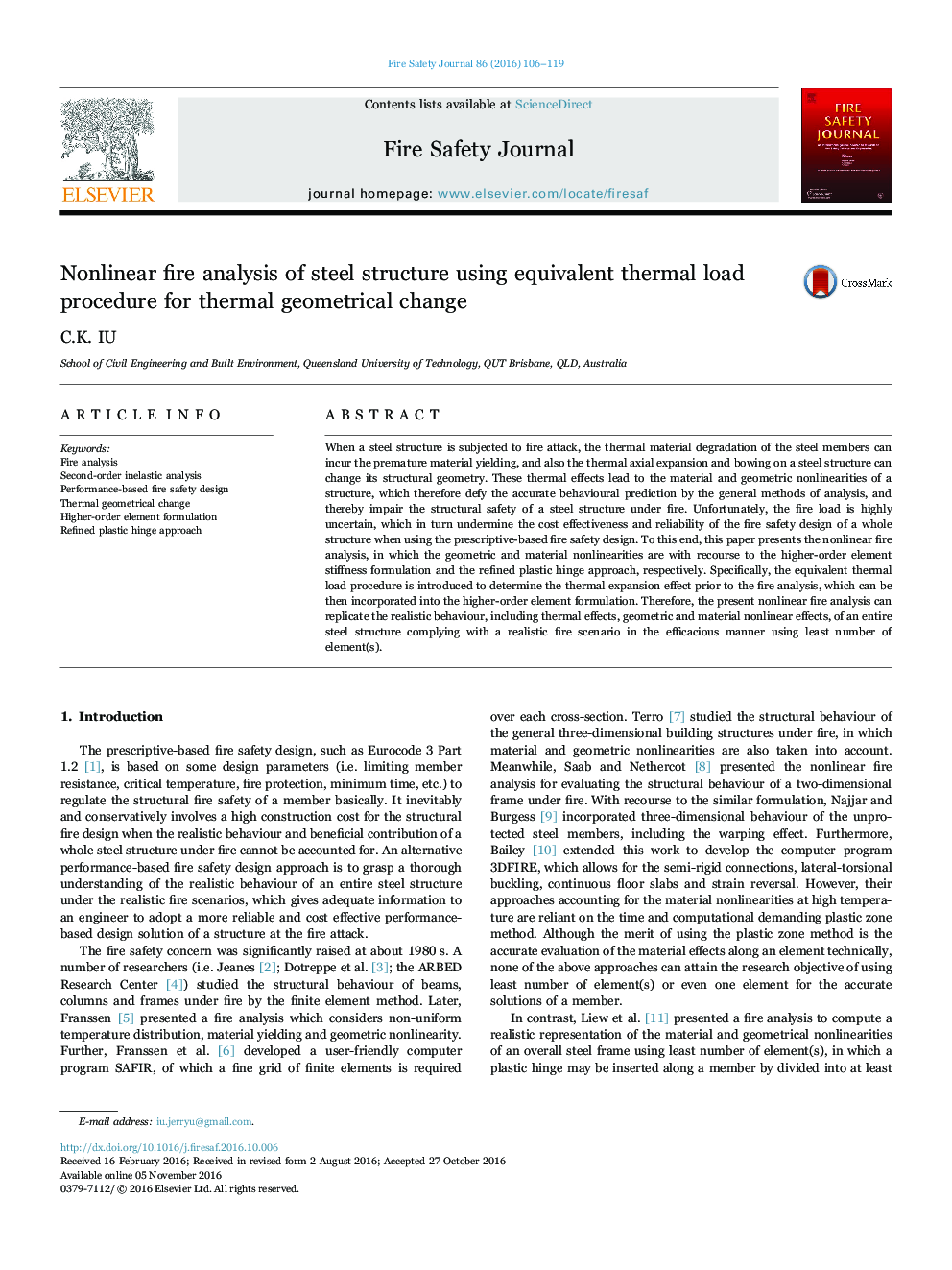| کد مقاله | کد نشریه | سال انتشار | مقاله انگلیسی | نسخه تمام متن |
|---|---|---|---|---|
| 4921015 | 1429217 | 2016 | 14 صفحه PDF | دانلود رایگان |
عنوان انگلیسی مقاله ISI
Nonlinear fire analysis of steel structure using equivalent thermal load procedure for thermal geometrical change
ترجمه فارسی عنوان
تجزیه و تحلیل آتش غیرخطی ساختار فولاد با استفاده از روش بار معادل حرارتی برای تغییر هندسی حرارتی
دانلود مقاله + سفارش ترجمه
دانلود مقاله ISI انگلیسی
رایگان برای ایرانیان
کلمات کلیدی
تجزیه و تحلیل آتش، تجزیه و تحلیل ناپیوسته مرتبه دوم، ایمنی طراحی بر اساس عملکرد، تغییر هندسی حرارتی، فرمول عنصر مرتبه بالاتر، رویکرد لولای پلاستیکی تصفیه شده،
ترجمه چکیده
هنگامی که یک ساختار فولادی مورد حمله قرار می گیرد، تخریب مواد حرارتی اعضای فولاد می تواند باعث تولید مواد زودرس شود، و همچنین گسترش محوری حرارتی و چسبیدن به یک ساختار فولادی می تواند هندسه ساختاری خود را تغییر دهد. این اثرات حرارتی منجر به ناهماهنگی مواد و هندسی یک ساختار می شود، که از اینرو پیش بینی دقیق رفتاری توسط روش های کلی تجزیه و تحلیل، و از این رو امنیت ایمنی سازه یک ساختار فولادی تحت آتش را مختل می کند. متاسفانه، مقدار آتش سوزی بسیار نامطمئن است، که به نوبه خود باعث کاهش کارایی و پایایی طراحی ایمنی آتشسوزی یک ساختار کل در هنگام استفاده از طراحی ایمنی آتشسوزی بر اساس پیش نویس می شود. برای این منظور، این مقاله تحلیل غیرخطی آتش را ارائه می دهد که در آن ناپایداری هندسی و مواد با استفاده از فرمول بندی سختی عناصر مرتبه بالاتر و رویکرد لولای پلاستیک تصفیه شده به ترتیب ارائه شده است. به طور خاص، روش بار معادل حرارتی معرفی شده برای تعیین اثر گسترش حرارتی قبل از تجزیه و تحلیل آتش است، که می تواند در فرمول عنصر مرتبه بالاتر قرار گیرد. بنابراین، تجزیه و تحلیل آتش غیر خطی در حال حاضر می تواند رفتار واقع گرایانه، از جمله اثرات حرارتی، اثرات غیر خطی هندسی و مواد، یک ساختار فولادی کامل که با یک سنسور آتش سوزی واقع گرایانه به کار گرفته می شود، با استفاده از حداقل تعداد عناصر، تکثیر کند.
موضوعات مرتبط
مهندسی و علوم پایه
سایر رشته های مهندسی
مهندسی عمران و سازه
چکیده انگلیسی
When a steel structure is subjected to fire attack, the thermal material degradation of the steel members can incur the premature material yielding, and also the thermal axial expansion and bowing on a steel structure can change its structural geometry. These thermal effects lead to the material and geometric nonlinearities of a structure, which therefore defy the accurate behavioural prediction by the general methods of analysis, and thereby impair the structural safety of a steel structure under fire. Unfortunately, the fire load is highly uncertain, which in turn undermine the cost effectiveness and reliability of the fire safety design of a whole structure when using the prescriptive-based fire safety design. To this end, this paper presents the nonlinear fire analysis, in which the geometric and material nonlinearities are with recourse to the higher-order element stiffness formulation and the refined plastic hinge approach, respectively. Specifically, the equivalent thermal load procedure is introduced to determine the thermal expansion effect prior to the fire analysis, which can be then incorporated into the higher-order element formulation. Therefore, the present nonlinear fire analysis can replicate the realistic behaviour, including thermal effects, geometric and material nonlinear effects, of an entire steel structure complying with a realistic fire scenario in the efficacious manner using least number of element(s).
ناشر
Database: Elsevier - ScienceDirect (ساینس دایرکت)
Journal: Fire Safety Journal - Volume 86, November 2016, Pages 106-119
Journal: Fire Safety Journal - Volume 86, November 2016, Pages 106-119
نویسندگان
C.K. IU,
